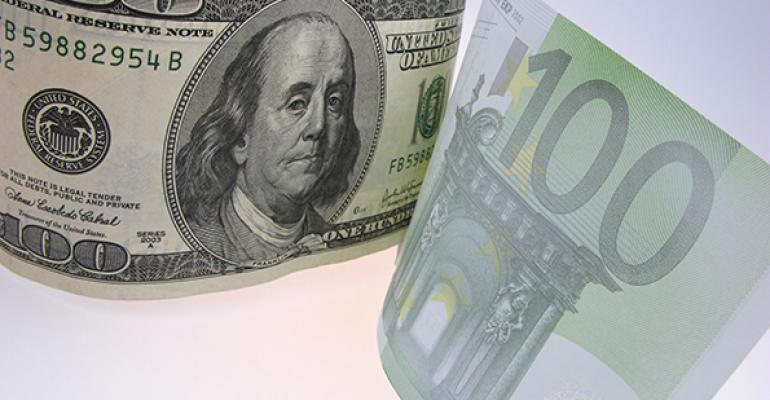Despite the weakening euro, Europe’s latest Quantitative Easing (QE) plan could spark additional real estate investing in the U.S. as European investors look for a safe haven for capital.
The European Central Bank announced in late January that it will purchase €60 billion (approximately $68 billion) worth of bonds a month until at least September 2016. The intent of that policy is to stimulate the still struggling European economy. If it works as intended, a strong economy will give Europeans more confidence—and access to capital—to boost real estate investment abroad. However, the more immediate impact has been a further weakening of the euro, which could fuel acquisitions in the U.S. for entirely different reasons.
The value of the euro against the dollar has dropped about 20 percent since last May, making U.S. real estate more expensive. Yet the weaker euro could serve as a big incentive for Europeans to increase acquisitions of U.S. assets. There is probably going to be a greater appetite to own dollar-denominated assets, because the euro is declining in value, while the dollar is increasing in value, says Steven Orchard, senior vice president in the structured finance group at commercial real estate services firm Transwestern.
“I don’t think you are going to see a massive reaction of Europeans coming in and trying to swoop up properties,” says Orchard. It won’t be like a “light switch being flipped,” because European investors are already here and they are already buying, he says. The European QE will likely accelerate that buyer demand as the year progresses, given expectations that the value of the euro will decline further, he adds.
Some European buyers have pulled back on U.S. investing in light of economic challenges in their home countries. However, there have been pockets of European investors and sovereign wealth funds that have remained active. For example, Norges Bank Investment Management has continued to be an active acquirer of U.S. real estate, including an announcement last week that the central bank of Norway acquired a stake in 11 Times Square in New York City.
Investors such as Norges may not want to miss out on opportunities. “A lot of investors see the U.S. in the accelerating phase of the real estate cycle, because the U.S. economy has strengthened ahead of Europe,” says Janice Stanton, senior managing director in the capital markets group at Cushman & Wakefield. Even though the value of the euro is down and expected to drop further over the next 12 months, people are expecting net operating incomes (NOIs) on U.S. properties to increase over the next couple of years, which would offset the weaker currency, she says.
Second fiddle?
The U.S. has been a desirable target for foreign capital in recent years. U.S. cross-border flows have quadrupled since 2010. Last year, foreign investors acquired about $44.7 billion in commercial real estate here, including properties valued at $5 million or greater, according to Real Capital Analytics (RCA), a New York City-based research firm. That’s up from $37.3 billion in acquisitions in 2013 and $11.7 billion in acquisitions in 2010.
However, European investors shopping for properties in the U.S. have been overshadowed by an influx of Asian buyers. Overall, activity from European buyers has been somewhat slower due to the sluggish economic recovery and concerns about a double dip recession in some European countries, notes Stanton. “We think that over the longer term, the QE is going to strengthen their economy and is going to bring European investors back faster. So the U.S. should see more capital coming from Europe,” she says.
Opinions differ on the extent of the QE impact on Europeans’ investment strategies.
“I think the effect will be marginal on European investment into the U.S.,” says David Green-Morgan, global capital markets research director for JLL Property Consultants in Singapore. “QE will undoubtedly provide more liquidity to European groups and also increase the availability of debt, but I see most of it being targeted within the EU rather than being exported.”
On the flip side, the strengthening dollar is expected to spark more activity from U.S. investors who are looking to acquire property in Europe. In fact, Cushman & Wakefield’s European team anticipates a 20 percent increase in investment sales volume this year, notes Stanton. The U.S. has been a net exporter of capital to Europe over 2014, with opportunistic buying on both the debt and equity side in countries such as Spain, Italy and Ireland.
“If that was attractive when the euro was stronger, that is super attractive now,” says Stanton.

